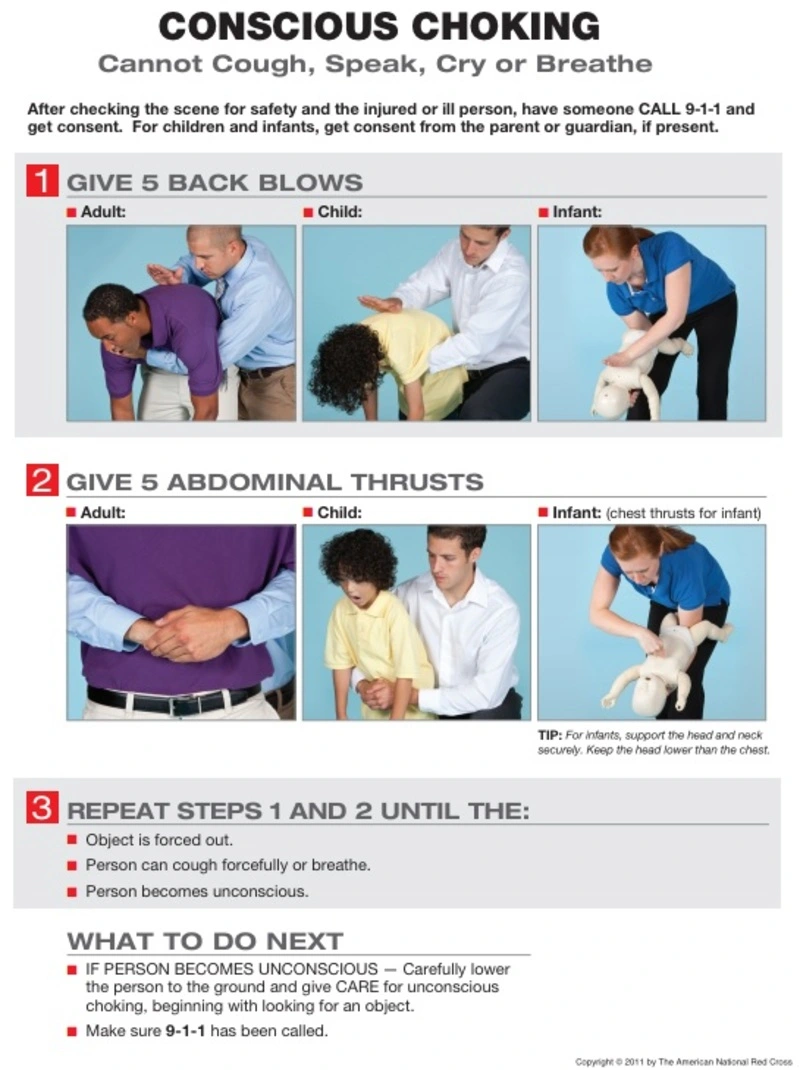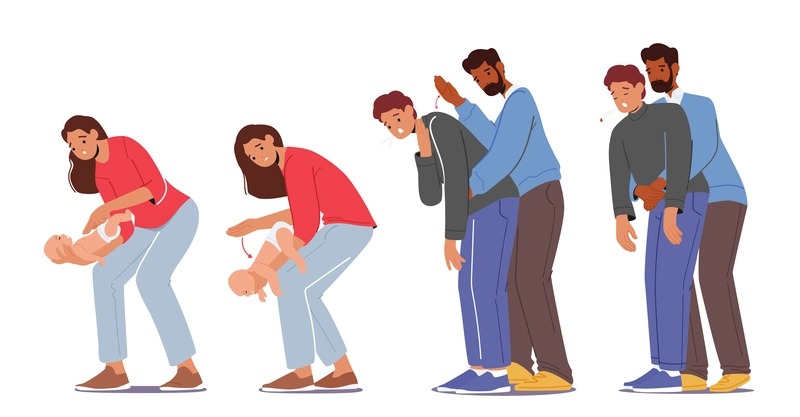Choking emergencies can happen anytime and to anyone, making them particularly frightening and requiring immediate action. Choking can lead to asphyxia, which can cause brain damage or even death. Hence, it is essential to learn the Heimlich maneuver, a simple yet effective technique that can save lives. In this blog post, we will discuss the importance of mastering the Heimlich maneuver, the step-by-step guide on performing it correctly, recognizing choking hazards and risk factors, and much more. Read on and empower yourself to be prepared to save lives.
The Importance of Mastering the Heimlich Maneuver: A Life-Saving Skill
Choking poses a significant and potentially life-threatening hazard that can unexpectedly occur in people of all ages. It is particularly concerning for young children and older adults due to their increased vulnerability. Choking incidents may arise from various reasons, including eating too quickly, talking while eating, swallowing large pieces of food, or even accidentally inhaling foreign objects. Possessing the knowledge and ability to perform the Heimlich maneuver can be the decisive factor between life and death in such critical situations.
The Heimlich maneuver, also known as abdominal thrusts, is a well-established and widely recognized emergency technique designed to dislodge foreign objects lodged in the airway. Studies and medical literature have demonstrated its remarkable effectiveness, with a success rate of over 80%. Its quick and straightforward execution makes it a vital skill that can be readily mastered by almost anyone, regardless of their medical background.
When someone chokes, their air supply becomes severely restricted or blocked, leading to asphyxia. Recognizing the signs of choking, such as difficulty breathing, coughing, or the inability to speak, is crucial in identifying the need for immediate intervention. The Heimlich maneuver acts rapidly by gradually increasing intra-abdominal pressure, forcing the diaphragm upward and expelling the obstructing object from the airway. This technique can be safely performed on conscious individuals and requires minimal physical strength, making it accessible to many.
Mastering the Heimlich maneuver is essential not only for individuals who may find themselves in choking emergencies but also for caregivers, parents, teachers, and anyone responsible for the well-being of others. Learning the Heimlich maneuver and other life-saving skills is an ongoing process. Regularly refreshing your knowledge through certified first aid training courses can ensure you are well-prepared to respond confidently in choking emergencies. Stay updated with any changes in guidelines and seek opportunities to practice these life-saving techniques to create a safer environment for yourself and those around you. Training and familiarization with the Heimlich maneuver should be promoted and encouraged within communities to ensure that as many people as possible are equipped with this life-saving skill.

History of the Heimlich Maneuver
The Heimlich maneuver, an iconic life-saving technique, was developed by Dr. Henry Heimlich in the 1970s, revolutionizing emergency response to choking incidents. After reading about the high mortality rates associated with choking accidents, Dr. Henry Heimlich, an American thoracic surgeon, became inspired to find a more effective method to aid choking victims. Motivated to improve survival rates in such cases, he dedicated his efforts to developing a technique that would swiftly and reliably dislodge obstructing objects from the airway.
In 1974, Dr. Heimlich first published his findings on the new maneuver in an article titled "Pop Goes the Cafe Coronary," which appeared in the Emergency Medicine journal. Shortly after, he expanded on the technique's principles and practical application in his book "Heimlich's Maneuvers: My Seventy Years of Lifesaving Innovation," providing comprehensive guidance on its use and impact.
The Heimlich maneuver rapidly gained recognition and widespread adoption within the medical community due to its simplicity and remarkable efficacy. Throughout the years, numerous lives have been saved by its timely administration, further cementing its reputation as a crucial life-saving skill.

Step-by-Step Guide: How to Perform the Heimlich Maneuver Properly
The Heimlich maneuver is a life-saving technique that can swiftly dislodge obstructing objects from the airway. To ensure its effectiveness, follow this step-by-step guide on how to perform it properly:
Assess the Situation: Quickly evaluate the situation to confirm that the person is choking. Common signs of choking include the inability to speak, cough effectively, or breathe properly.
Stand Behind the Person: Position yourself behind the choking individual and maintain a stable stance.
Locate the Navel: Identify the person's navel, typically located between the bottom of the ribcage and the top of the hips.
Form a Fist: Make a fist with one hand and place the thumb side of the fist against the person's abdomen, just above the navel.
Grasp with Other Hand: With your other hand, firmly grasp the fist you placed on the person's abdomen.
Perform Quick Upward Thrusts: Using a quick and upward motion, thrust your hands inward and upward into the person's abdomen. The aim is to increase intra-abdominal pressure, forcing air from the lungs to expel the obstructing object.
Repeat if Necessary: If the object is not expelled after the first thrust, repeat the procedure until the airway is clear or until professional medical help arrives.
Unconscious Person: If the choking individual becomes unconscious, carefully lower them to the ground while maintaining support. Call for emergency medical assistance immediately.
Begin CPR (if necessary): If the person remains unresponsive after the Heimlich maneuver and emergency medical help have been summoned, initiate cardiopulmonary resuscitation (CPR) with chest compressions and rescue breaths until help arrives.
It is crucial to remember that the Heimlich maneuver is intended for conscious individuals who can still cough or make sounds. A modified version of the maneuver involving back blows and chest thrusts is more appropriate for infants and young children.

Tailoring the Technique: Adjusting the Heimlich Maneuver for Different Age Groups and in solo emergencies
The Heimlich maneuver, while effective for individuals of various age groups and body types, can be tailored to suit specific needs and considerations. Adapting the technique ensures the most appropriate and safe response in choking emergencies.
Infants
When dealing with a choking infant, it is crucial to follow a modified approach to ensure their safety. Here's a concise step-by-step guide for infant choking emergencies:
Assess the Situation: Verify that the infant is indeed choking. Watch for signs such as difficulty breathing, gasping, or inability to cry or make sounds.
Support the Infant: Hold the baby face down on your forearm, ensuring their head is lower than their chest.
Deliver Back Blows: Use the heel of your free hand to deliver five firm back blows between the baby's shoulder blades.
Perform Chest Thrusts: Turn the infant face-up while supporting the head and neck. Place two fingers at the center of the baby's chest just below the nipple line and perform five quick chest thrusts.
Repeat if Necessary: Continue alternating between back blows and chest thrusts until the object is expelled or professional medical help arrives.
Seek Medical Attention: Even if successful in clearing the airway, it is essential to have the infant examined by a healthcare professional to ensure their well-being.
Children and Adults
The Heimlich maneuver for children above one year old is similar to that for adults but with slight modifications to suit their age and body size. When performing the technique on children, the rescuer should stand behind the choking child and place the fist just above the child's navel, using a quick and upward thrust to generate intra-abdominal pressure. Unlike in adults, where the technique is executed above the navel, the modification in children ensures the maneuver remains effective for dislodging obstructing objects from their smaller airways. Additionally, seeking immediate medical attention for the child's safety is crucial, even if the object is expelled successfully.
Pregnant Women
When dealing with a choking emergency involving a pregnant woman, it is essential to consider her altered anatomy due to the growing uterus. In this situation, traditional abdominal thrusts may not be suitable. Instead, use upward thrusts with the lower part of the sternum (breastbone) to generate enough pressure to dislodge the obstructing object while considering the pregnant individual's specific needs.
Assess the Situation: Confirm that the pregnant woman is indeed choking. Watch for signs such as difficulty breathing, clutching the throat, or appearing distressed.
Positioning: Stand behind the choking woman and ensure she is in an upright position.
Locate the Lower Sternum: Identify the lower part of the sternum, located at the center of the chest, just above the upper abdomen.
Form a Fist: Make a fist with one hand and place the thumb side against the lower part of the sternum.
Grasp with Other Hand: Use your other hand to firmly grasp the fist you placed on the woman's sternum.
Perform Upward Thrusts: Using a quick and upward motion, thrust your hands inward and upward into the lower part of the sternum. The goal is to generate enough pressure to dislodge the obstructing object while considering the altered anatomy of the pregnant individual.
Repeat if Necessary: If the object is not expelled after the first thrust, repeat the procedure until the airway is clear or until professional medical help arrives.
Obese Individuals
For individuals who are obese, adjusting the Heimlich maneuver is also essential to ensure effectiveness. The increased body size may limit the effectiveness of traditional abdominal thrusts.
Assess the Situation: Confirm that the person is indeed choking. Observe for signs of choking, such as difficulty breathing or clutching the throat.
Positioning: Stand behind the choking individual and ensure they are in an upright position.
Locate the Lower Sternum: Identify the lower part of the sternum, located at the center of the chest, just above the upper abdomen.
Form a Fist: Make a fist with one hand and place the thumb side against the lower part of the sternum.
Grasp with Other Hand: Use your other hand to firmly grasp the fist you placed on the individual's sternum.
Perform Upward Thrusts: Using a quick and upward motion, thrust your hands inward and upward into the lower part of the sternum. Apply adequate force to expel the obstructing material from the airway, considering the individual's larger body size.
Repeat if Necessary: If the object is not expelled after the first thrust, repeat the procedure until the airway is clear or until professional medical help arrives.
Self-Administered Heimlich Maneuver
If someone is choking and finds themselves alone, it can be a frightening and critical situation. In such cases, the self-administered Heimlich maneuver can be a potential lifesaver. To perform the maneuver, the person should make a fist and place it just below the ribcage and above the navel, with the thumb side against the upper abdomen. The other hand should firmly grasp the fist. By delivering inward and upward thrusts, they can attempt to expel the obstructing object and clear their airway. It's crucial to remember that this technique should only be tried if the individual can still cough, speak, or breathe, even with difficulty. If the choking persists, the person should seek immediate medical help. In some situations, additional objects like the back of a chair or a countertop can be used to apply pressure to the abdomen, enhancing the effectiveness of the self-administered maneuver.
Remember, seeking immediate medical attention is crucial, even if the object is successfully expelled. Healthcare professionals can provide further evaluation and ensure the individual's well-being after a choking incident.

Recognizing Choking Hazard Signs: Identifying Critical Indications of Airway Obstruction
Choking emergencies can occur suddenly and pose a serious risk to people of all ages. Recognizing the signs of choking is crucial in identifying when immediate intervention is required. The following are essential indicators that someone may be experiencing a choking incident:
For Adults and Older Children:
- Difficulty Breathing: One of the most common signs of choking is difficulty breathing or shortness of breath. The person may gasp for air, wheeze, or make unusual sounds while trying to breathe.
- Coughing or Gagging: Persistent and forceful coughing or gagging may be an attempt by the body to expel the obstructing object. However, if coughing is ineffective or the person cannot produce sound, it could indicate a severe blockage in the airway.
- Inability to Speak: If the person cannot speak or produce weak, raspy sounds, it may be a sign of partial or complete airway obstruction.
- Clutching the Throat: The person may instinctively reach for their throat, indicating discomfort or the sensation of something being stuck.
- Bluish or Reddish Skin: Choking can lead to a lack of oxygen, resulting in changes in skin color. The person's skin may turn blue (cyanosis) or reddish (flushing) due to the lack of oxygen supply.
- Panicked or Distressed Expression: A person experiencing choking may display signs of fear, panic, or anxiety, seeking help or appearing distressed.
- Loss of Consciousness: In severe choking incidents, loss of consciousness may occur due to oxygen deprivation. If the person becomes unresponsive, immediate medical help should be sought.
For Infants and Young Children:
- Difficulty Breathing: Watch for labored breathing, rapid breathing, or gasping for breath.
- Coughing or Gagging: Children may cough forcefully as their natural response to choking.
- High-Pitched Noises: Listen for high-pitched or squeaky sounds while breathing.
- Inability to Cry or Make Sounds: If the child cannot make sounds or has weak cries, it could indicate a choking incident.
- Clutching the Throat or Chest: The child may hold their throat or chest as a sign of discomfort.
- Bluish or Reddish Skin: Check for changes in skin color, such as turning blue or red.
- Loss of Consciousness: If the child becomes unresponsive, seek immediate medical help.
It is essential to remain vigilant and act promptly when observing these signs, as timely intervention can be life-saving. If you suspect someone is choking, take immediate action by performing the Heimlich maneuver for adults and older children, using back blows and chest thrusts for infants and young children, or seeking professional medical help without delay. Remember, seeking proper medical assistance is crucial even after the successful execution of the maneuvers to ensure a comprehensive evaluation and further management. By recognizing these choking hazard signs, you can play a pivotal role in averting potential tragedies and promoting safety within your community.
Practicing Preparedness: When and Where to Use the Heimlich Maneuver
Choking can happen unexpectedly in various settings, such as restaurants, homes, schools, or public places, making it essential for individuals to be prepared to act swiftly and effectively.
In Restaurants: Choking incidents can occur during meals in restaurants, where people may be eating quickly or not chewing their food thoroughly. If you witness someone choking at a restaurant, knowing how to perform the Heimlich maneuver can enable you to respond promptly and assist the choking individual until professional help arrives.
In Homes: Choking incidents can happen during family gatherings or while individuals eat alone at home. Being familiar with the Heimlich maneuver is particularly vital in households with children or elderly family members who are more vulnerable to choking. Quick action can make all the difference in these situations.
In Public Places: Choking emergencies can happen anytime, even in crowded public spaces. Concert venues, parks, shopping malls, and workplaces are just a few examples of places where someone may experience choking. Being prepared to administer the Heimlich maneuver can help you provide immediate aid to the affected person, increasing their chances of survival.
Age-Appropriate Choking Hazards and Preventive Measures
To prevent choking incidents and promote safety across all age groups, several preventive measures can be adopted:
Infants and Toddlers (Up to 3 Years Old): Ensuring the safety of infants and toddlers during meals and playtime is crucial. Avoid giving them whole grapes, cherry tomatoes, or small, round foods to prevent choking incidents. Instead, cut these foods into small pieces or quarters to reduce the likelihood of obstruction. Remember to remove pits from fruits like cherries or peaches before serving. It is essential to keep hard or sticky candies away from young children, as they can easily become lodged in their airways. Moreover, ensure that small toys, coins, buttons, marbles, and other objects are kept out of their reach, as young children often explore the world by putting items in their mouths.
Young Children (4 to 6 Years Old): As children grow older, choking risks can still be present. For young children aged 4 to 6 years, continue to avoid giving them small, round foods and provide these items in a safe, cut-up form. Foods like popcorn and hard candy should be avoided due to their choking hazard potential. Additionally, ensure that their toys and games are age-appropriate and do not have small parts that could be swallowed accidentally, posing a choking risk.
Older Children (7 to 12 Years Old): As children age 7 to 12 years, education about safe eating habits becomes increasingly important. Emphasize the importance of chewing food thoroughly and not rushing while eating. Remind them not to talk or laugh with a mouthful of food, as this can increase the risk of choking. When serving foods like hot dogs, sausages, or hard candies, supervise them to reduce the likelihood of choking incidents.
Teens, Adults, and the Elderly: Choking hazards can affect individuals of all ages, including teens, adults, and the elderly. Certain foods, especially those that are hard, round, or sticky, can pose a choking risk. It is essential for everyone to be mindful of their eating habits and chew food thoroughly to prevent choking incidents. For older people, age-related factors such as poor dental health, diminished muscle strength, and swallowing difficulties (dysphagia) can increase the likelihood of choking. Additionally, certain medications may have side effects that affect swallowing. Family members and caregivers should be attentive to these potential hazards and work with healthcare professionals to manage and address swallowing difficulties in elderly individuals to minimize the risk of choking incidents.
Navigating the Heimlich Maneuver: Potential Risks and Complications
The Heimlich maneuver is a valuable life-saving technique, but it's essential to be aware of its potential risks and complications, especially when applying it to certain age groups or situations. Let's delve into some specific examples and situations to gain more clarity.
· Risk of Injury: The Heimlich maneuver involves forceful abdominal thrusts to expel an obstructing object from the airway. While it can be effective, it also carries the risk of causing injuries, particularly to the chest area. For instance, if the maneuver is administered incorrectly, it may lead to broken ribs or damage to internal organs. This risk is particularly concerning when dealing with fragile individuals, such as older people or those with pre-existing medical conditions that affect bone density.
· Children and Elderly: Extra care must be exercised when applying the Heimlich maneuver on young children or elderly individuals. Their bodies are more delicate and susceptible to harm. In children, the force applied during the maneuver should be modified to suit their size and strength to avoid injuries. For older adults, especially those with conditions like osteoporosis, gentler and more controlled thrusts are necessary to prevent fractures.
· Situations Where the Heimlich Maneuver May Not Work: Sometimes, the Heimlich maneuver may not successfully dislodge the obstructing object. For example, if the object is large and solid, it might be difficult to dislodge solely through abdominal thrusts. In such cases, immediate medical attention is crucial to prevent further complications. Knowing when the Heimlich maneuver might not be sufficient helps prompt individuals to seek professional assistance promptly.
· Pregnant Women: Pregnant women require special consideration when administering the Heimlich maneuver. The traditional abdominal thrusts may put unnecessary pressure on the abdomen and may not suit their condition. Instead, alternative techniques, such as chest thrusts or back blows, should be used to clear the airway safely without harming the mother or the unborn child.
· Conscious Individuals Who Do Not Require the Heimlich Maneuver: Applying the Heimlich maneuver to conscious individuals who are not choking can be distressing and harmful. Before attempting the maneuver, ensuring that the person is genuinely experiencing a choking emergency is essential. Signs such as severe coughing or difficulty breathing should prompt the application of the Heimlich maneuver.
While the Heimlich maneuver is a valuable life-saving skill, seeking formal first-aid training from certified instructors or healthcare professionals is essential to learn the technique correctly. Always call for professional medical help immediately in a choking emergency, even after successfully performing the Heimlich maneuver. Acquiring certified first aid training is crucial for individuals to understand the appropriate scenarios for performing the Heimlich maneuver and to be well-prepared for potential risks and complications. By being mindful of these factors and clearly understanding when and how to use the Heimlich maneuver, one can confidently approach choking emergencies and respond effectively while minimizing the likelihood of adverse outcomes.
Conclusion
Choking incidents can strike unexpectedly, affecting people of all ages. Be prepared to respond swiftly and effectively at home, in restaurants, or in public places. With Cura4U's up-to-date medical knowledge and personalized doctor consultations, learn the correct technique and gain valuable insights on choking emergencies and preventive measures. Our comprehensive healthcare services empower you to make informed choices, fostering a safer environment for yourself and those around you. However, remember that the information provided here is only for general awareness and educational purposes and should not replace professional medical advice or training. Seeking immediate professional medical assistance is crucial for a comprehensive evaluation and further management. Take action now and empower yourself with life-saving knowledge. Together, let's create a safer community where everyone is prepared to act confidently in choking emergencies. Preparedness is the key to saving lives. Act now!
Our clinical experts continually monitor the health and medical content posted on CURA4U, and we update our blogs and articles when new information becomes available. Last reviewed by Dr. Tayyab Saeed Akhter on July 26th, 2023.
References
Heimlich maneuver on self: MedlinePlus Medical Encyclopedia- https://medlineplus.gov/ency/article/001983.htm
How To Do the Heimlich Maneuver in the Conscious Adult or Child - Critical Care Medicine - MSD Manual Professional Edition (msdmanuals.com)- https://www.msdmanuals.com/professional/critical-care-medicine/how-to-do-basic-airway-procedures/how-to-do-the-heimlich-maneuver-in-the-conscious-adult-or-child
Abdominal Thrust Maneuver - StatPearls - NCBI Bookshelf (nih.gov)- https://www.ncbi.nlm.nih.gov/books/NBK531467/
Learn the Heimlich Maneuver: Proper First Aid for Choking (emergencyphysicians.org)-https://www.emergencyphysicians.org/article/health--safety-tips/choking--heimlich-manuever
Abdominal thrusts: MedlinePlus Medical Encyclopedia- https://medlineplus.gov/ency/article/000047.htm
Choking: First Aid and Prevention | Johns Hopkins Medicine- https://www.hopkinsmedicine.org/health/wellness-and-prevention/choking-first-aid
Pop Goes the Café Coronary (gwern.net)- https://gwern.net/doc/biology/1974-heimlich.pdf
Heimlich's Maneuvers: My Seventy Years of Lifesaving Innovation by Henry J. Heimlich | eBook | Barnes & Noble® (barnesandnoble.com)- https://www.barnesandnoble.com/w/heimlichs-maneuvers-henry-j-heimlich/1115292777
The Heimlich Maneuver. (cdc.gov)
Complications as a Result of the Heimlich Maneuver : Journal of Trauma and Acute Care Surgery (lww.com)- https://journals.lww.com/jtrauma/Fulltext/2009/03000/Complications_as_a_Result_of_the_Heimlich_Maneuver.55.aspx
















